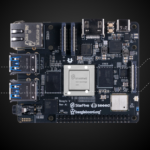Seeed launches BeagleV, a $150 RISC-V computer designed to run Linux


Seeed Studios—the makers of the Odyssey mini-PC we reviewed back in August—have teamed up with well-known SBC vendor BeagleBoard to produce an affordable RISC-V system designed to run Linux.
The new BeagleV (pronounced "Beagle Five") system features a dual-core, 1GHz RISC-V CPU made by StarFive—one of a network of RISC-V startups created by better-known RISC-V vendor SiFive. The CPU is based on two of SiFive's U74 Standard Cores—and unlike simpler microcontroller-only designs, it features a MMU and all the other trimmings necessary to run full-fledged modern operating systems such as Linux distributions.
-

- Login or register to post comments
 Printer-friendly version
Printer-friendly version- 7103 reads
 PDF version
PDF version
More in Tux Machines
- Highlights
- Front Page
- Latest Headlines
- Archive
- Recent comments
- All-Time Popular Stories
- Hot Topics
- New Members
digiKam 7.7.0 is released
After three months of active maintenance and another bug triage, the digiKam team is proud to present version 7.7.0 of its open source digital photo manager. See below the list of most important features coming with this release.
|
Dilution and Misuse of the "Linux" Brand
|
Samsung, Red Hat to Work on Linux Drivers for Future Tech
The metaverse is expected to uproot system design as we know it, and Samsung is one of many hardware vendors re-imagining data center infrastructure in preparation for a parallel 3D world.
Samsung is working on new memory technologies that provide faster bandwidth inside hardware for data to travel between CPUs, storage and other computing resources. The company also announced it was partnering with Red Hat to ensure these technologies have Linux compatibility.
|
today's howtos
|









.svg_.png)
 Content (where original) is available under CC-BY-SA, copyrighted by original author/s.
Content (where original) is available under CC-BY-SA, copyrighted by original author/s.

$119+ BeagleV powerful, open-hardware RISC-V Linux SBC targets
$119+ BeagleV powerful, open-hardware RISC-V Linux SBC targets AI applications
BeagleV is a RISC-V single board PC for $150 or less
BeagleV is a RISC-V single board PC for $150 or less
Introducing the first affordable RISC-V board designed to run...
Introducing the first affordable RISC-V board designed to run Linux
At Last: an Affordable RISC-V Board With Desktop Linux Support
At Last: an Affordable RISC-V Board With Desktop Linux Support
Comments in Slashdot
BeagleV is a $150 RISC-V Computer Designed To Run Linux
BeagleV SBC runs Linux on AI-enabled RISC-V SoC
BeagleV SBC runs Linux on AI-enabled RISC-V SoC
BeagleBoard.org and Seeed Introduce the First Affordable RISC-V
BeagleBoard.org and Seeed Introduce the First Affordable RISC-V Board Designed to Run Linux
BeagleV: An Affordable RISC-V Computer Designed to Run Linux
BeagleV: An Affordable RISC-V Computer Designed to Run Linux
BeagleV is a RISC-V single board PC for $150 or less
BeagleV is a RISC-V single board PC for $150 or less
New Beagle Board Offers Dual-Core RISC-V
New Beagle Board Offers Dual-Core RISC-V, Targets AI Applications
BeagleV: A powerful RISC-V single-board computer that runs Linux
BeagleV: A powerful RISC-V single-board computer that runs Linux from US$119